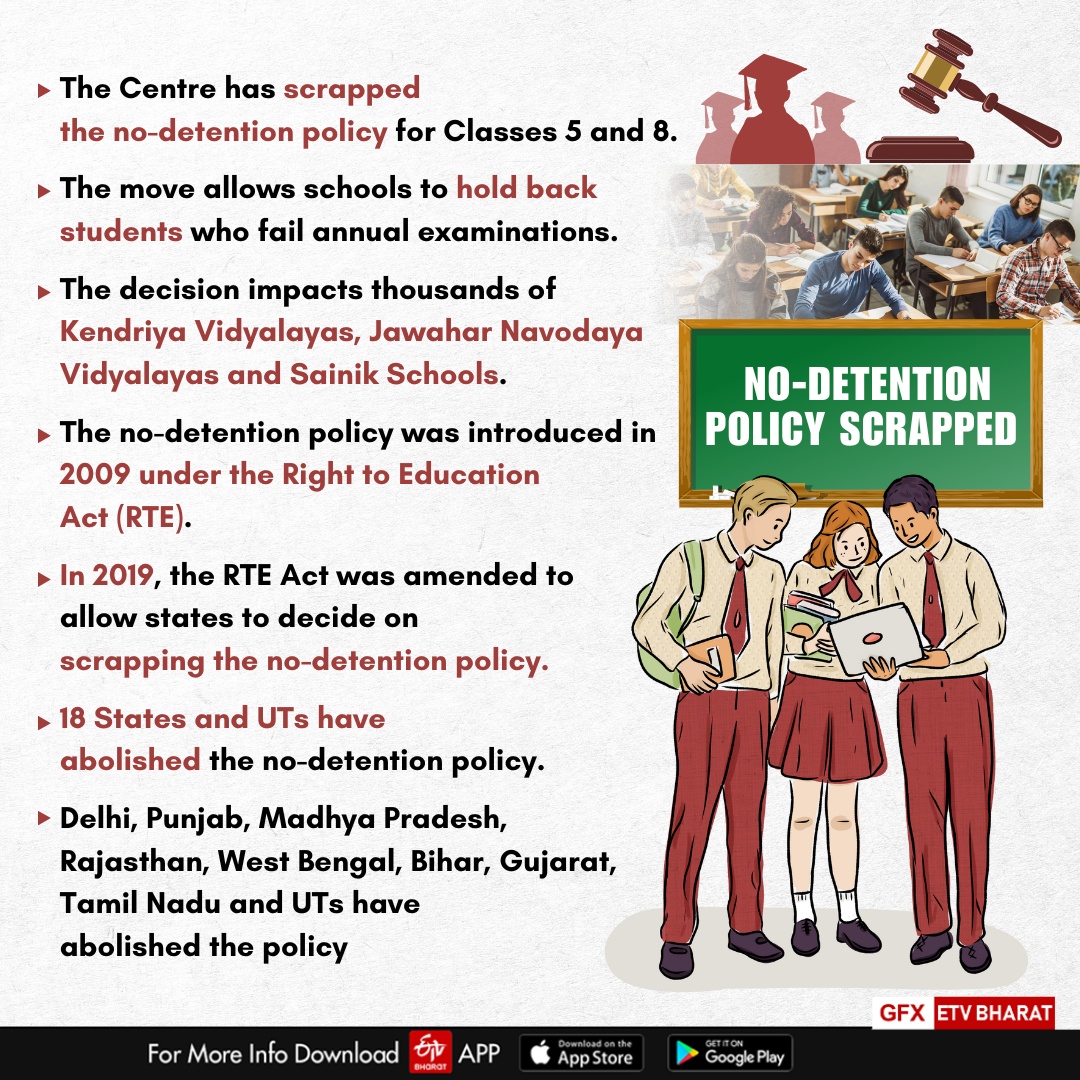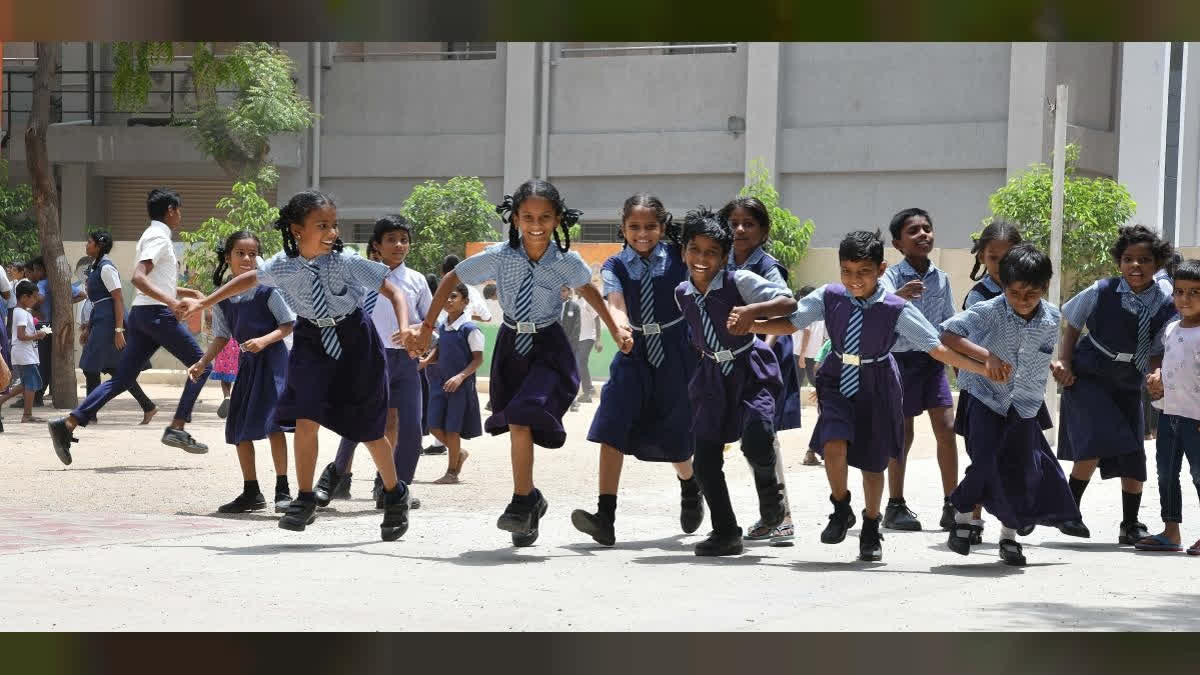By Dr G. Jagan Mohan Rao
The Government of India’s no-detention policy was introduced in 2009 under the Right to Education Act (RTE). The policy was intended to ensure that students complete at least elementary education without dropping out of school. The Annual Status Education Report (ASER), 2022 highlighted that only 20% of Class 3 students in rural India could read Class 2 level textbooks fluently in their regional language.
Non-detention Policy has led to lethargy among students and educators, resulting in a decline in educational standards. In 2019, the RTE Act was amended to allow States to decide on scraping the no-detention policy. Since then 18 States including Delhi, Punjab, Madhya Pradesh, Rajasthan, West Bengal, Bihar, Gujarat, Tamil Nadu and UTs have abolished the no-detention policy.

The Central Government has scrapped the no-detention policy for Class 5 and 8 under its jurisdiction. This includes over 3000 Central schools including Kendriya Vidyalas, Jawahar Navoday Vidyalaya, Sainik School and Eklavya Model Residential School. Now it is the turn of Telugu-speaking states to decide on this. In this context, the historical development of no-detention policy in the undivided State of Andhra Pradesh, the assessment procedures, the gaps, and emerging solutions are discussed in this article.
National Education Policy 2020 envisages that the extant 10+2 structure in school education will be modified with new pedagogical and curricular structuring of 5+3+3+4 covering ages 3-18. Currently, children in the age group of 3-6 are not covered in the 10+2 structure, as Class 1 begins at the age of 6. The foundation stage consists of two parts; 3 years of Anganwadi/Pre-school + 2 years in Primary school in grades 1-2; both together covering ages 3-8, preparatory stage - grades 3-5 covering ages 8-11, Middle stage - grades 6-8 covering age 11-14 and Secondary stage - grades 9-12 in two phases, i.e., 9 and 10 in the first and 11 and 12 in the second, covering ages 14-18.
The policy envisages a transformation of assessment procedures for student development. While the Board exams for grades 10 (SSC) and 12 (Intermediate) will be continued, to track progress throughout the school years, not just at the end of grades 10 and 12, for the benefit of students, parents, teachers, principals and the entire schooling system – all students will take school examination in grades 3, 5 and 8 which will be conducted by the appropriate authority (Board).
National-level assessment surveys reveal that the achievement levels of students at the transformation stage are far below the expected level. At the end of stage 8, a marginal number of students only possess the expected competencies, while a large number of students do not possess competencies in literacy and numeracy. The gaps in achievement levels are attributed to ineffective curriculum transactions and a non-detention system. In this context, it is envisaged to introduce a detention system at stage 5 and 8 with certain modifications.
As far back as 1966 the report of the Kothari Commission had indicated that progressively the system of detention at the school level should be done away with, replacing it with the adoption of a new pattern of instruction and evaluation in the classroom, which would make detention at the school level really irrelevant and unnecessary. Even though the Kothari Commission had made a rather cautious approach to this by suggesting the abolition of detention at the level of class I where the incidence of stagnation and wastage, for a variety of reasons such as financial, sociological and academic, was the steepest.
The Government of Andhra Pradesh went much further and abolished detention through the whole gamut of Primary and Secondary education, retaining the principle of detention only at two levels, namely the 7th Class which is the terminal point in Primary education and 10th Class in Secondary education.
The Government of Andhra Pradesh vide GO Ms.No.1781, dated 27-11-1971 introduced a new evolution policy in order to address the problems of stagnation and wastage. The detention system in all classes except in Class VII and X was abolished and a new policy of continuous and comprehensive education was introduced. The broad procedure involved in the new procedure is given below.
Primary stage of Education (Class I to IV)
According to the new policy, the teachers have to prepare tests, which include oral, written and practical aspects based on the specific objectives defined. The results are to be entered systematically into the two important records, namely the Progress Card and the cumulative record. Home assignments and class work should also be considered as a part of the evaluation.
Upper Primary Stage of Education (Class V to VII)
The entire syllabus of the year is divided into convenient units. Based on these units, Unit Tests are conducted. Results of these teacher-made-test are to be entered in the Progress Cards. Besides Unit tests, Quarterly, Half-years and Annual examinations are to be conducted; and the overall assessment is to be entered in cumulative records in the form of Grades.
At the end of the Upper Primacy stage, a Common Promotion examination is to be conducted at the District level. The District Educational Officer is the Chairman of the Common Examination Board and is vested with the authority of conducting the Common examination and issuing the Upper Primacy School Leaving Certificate. The weightage to be given for the different tests is as follows:
25% weightage to Quarterly and Half-years examinations and 50% weightage to the Annual examination.
Attendance
The minimum attendance required for each student and the Primary stage is 80% and for the Secondary stage it is 90%. The Headmaster is vested with the power of condoning 10% of attendance in special cases for unavoidable reasons.
Attendance in various tests is compulsory and the tests are re-administered if some of the pupils fail to take them due to unavoidable reasons. If the student’s performance is satisfactory in all tests and examinations, the attendance requirement can be 60%.
This being the expected methodology, the present scenario of the evaluation procedure can be briefly stated as follows:-
Block level (now Mandal) examination at the end of Class-V was abolished long back. Class-VII examination which was conducted at the District level was also abolished due to certain practical difficulties. It is only at the end of Class-X, i.e. SSC, Board examination is conducted. The evaluation procedures adopted at the SSC level have become still worse.
In order to avoid threats like leakage of question paper, the Board has adopted a very cumbersome procedure. The DEO who is the quality controlling officer at the district level, has to spend more time on conducting examinations and attending spot valuation. Unfortunately, the results of SSC examinations have become the indicators for assessing the standards of Secondary schools.
Keeping this in view, in order to compete with private schools, the officials of school education fixed targets to schools. As a result, the schools are adopting unfair means to achieve targets. In 2024 March while the pass cartage of SSC is 91.31%; the pass cartage of Intermediate 1st year is 60.01%. At Class-X the weightage given for Board examination is 80% and for internal assessment 20%.
The pass mark is 35%. That is to say, if a student gets 28 marks in the Board exam he will get through the examination. The 28 marks the student gets in the Board examination cannot be attributed to his actual performance. It is learnt that inspite of rigorous steps taken to check malpractices at the examination centre, cases of mass malpractices in the examination center are reported. Subjectivity in paper valuation cannot be ruled out. Thus, the marks scored in SSC do not represent the student’s actual competency and performance.
Assessment Procedures:
Formative and summative evaluations are taken up at the school level. For formative evaluation 20 marks and for Summative evaluation, 80 marks are earmarked. Proper weightages are given to test the learning outcomes of students in each area. Project work is given. Marks scored are recorded in the progress record. Though the testing procedure and reporting system look scientific, the procedure adopted looks cumbersome. In Government schools, neither the parents nor the students pay attention on the tests. It is reported that conducting tests has become a herculean task for the teachers. Added to this self-evaluation procedures for teachers is introduced which is based on the performance of the students. Students’ performance in the tests has become the indicator to assess the competency and commitment of the teachers.
Conclusion
Non-detention policy has led to in-complacency among students, teachers and educators, resulting in a decline in educational standards. Automatic promotion without necessary knowledge and skills in lower standards has led to increased failure rates at secondary and higher secondary stages. The policy has reduced accountability among students and teachers, as students are automatically promoted to the next grade regardless of their performance.
The policy does not address the root cause of poor learning outcomes, inadequate teacher training, lack of infrastructure, guidance and supervision and socio-economic factors. Educational institutions at the secondary level have become centres to issue certificates which are not based on learning outcomes but simply on attending school. They are as good as fake certificates. Education aims to empower the child.
Empowerment takes place only when the student achieves competency. When competencies are not achieved, what is the use of education? What is the value of these certificates? Low achievement in the secondary stage is the result of low achievement at the primary level. Therefore, primary education which is the foundation stage is very crucial.
National Policy 2020 envisages the merging of the pre-primary section to the primary. The teachers working in primary schools, even though trained in DIETs, do not possess the pedagogical skills required to handle pre-primary classes. Therefore, pre-primary trained teachers need to be appointed; while anganwadies do take care of children aged 3 years.
At the primary stage, the focus of learning should be learning to learn. Children are born with innate abilities. Therefore the teacher at the primary stage has to provide self-learning activities, thereby learning continues forever. If the classroom activities at the early stage are attractive involving children, learning becomes effective and automatic. Thus the child not only gets competencies but develops an interest towards schooling. If this is taken care of, the question of dropouts will not arise.
The introduction of a detention system at Class V and VIII will ensure the maintenance of standards. The system will keep the students on track, develop interest in studies resulting in involvement in classroom activities and take the tests as challenging tasks. Thus, if good standards are maintained at the primary stage, students at the secondary level will certainly achieve the learning outcomes.
There is a lot of awareness among the people towards education. The poorest of the poor have recognised the value of education and are sending their children to school. If classroom activities are attractive, if the child’s learning outcome is progressively visible, the behavioural modification takes, and no parent withdraws the child from school. The arguments against the introduction of a detention system will result in dropouts is hypothetical.
It is stated that already 18 states in the country have switched over to Detention Policy at Class V and VIII, including the schools managed by Central Government and UTs; quite obviously the State Governments of Telangana and Andhra Pradesh have no option except to accept the proposal of Detention Policy at Class V and VIII and implement it in true spirit with due focus on primary education.
(Disclaimer: The opinions expressed in this article are those of the writer. The facts and opinions expressed here do not reflect the views of ETV Bharat)



